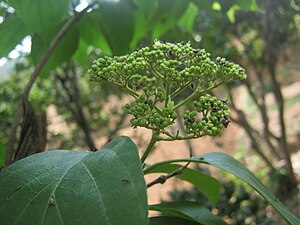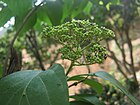Note: This is a project under development. The articles on this wiki are just being initiated and broadly incomplete. You can Help creating new pages.
Premna mucronata - Agnimantha
Agnimantha or botanically Premna Integrifolia is an important ingredient of Dashmool Plants. Dashmool has two subcategories Brihat Panchamoola and Laghu Panchamoola. Agnimantha is included under Brihat Panchamoola. All these plants have anti-rheumatic, anti-inflammatory and analgesic properties.
Uses
Loss of Appetite & Malabsorption, Lymphadenitis, Piles, Hemorrhoids, Neuralgia, Obesity, Urticaria, Chyluria, Urinary trouble, Joint pain, Fever, Vata Disorders.
Parts Used
Chemical Composition
Linalool, Linoleic acid, P-methoxy cinnamic acid, aphelandrine, Caryophellen, Clerodendrin-A, Canikarine, Iridoid glycoside, Luteolin[1]
Common names
| Language | Common name |
|---|---|
| Kannada | |
| Hindi | Agathu, Arni, Ganiyaar, Agethu |
| Malayalam | |
| Tamil | Pachumullai, Taludalai |
| Telugu | |
| Marathi | NA |
| Gujarathi | NA |
| Punjabi | NA |
| Kashmiri | NA |
| Sanskrit | Agnimantha, Vatghani, Shreeparn |
| English | Headache Tree |
Properties
Reference: Dravya - Substance, Rasa - Taste, Guna - Qualities, Veerya - Potency, Vipaka - Post-digesion effect, Karma - Pharmacological activity, Prabhava - Therepeutics.
Dravya
Rasa
Guna
Veerya
Vipaka
Karma
Prabhava
Habit
Identification
Leaf
| Kind | Shape | Feature |
|---|---|---|
| Paripinnate | Oblong | Leaf Arrangementis Alternate-spiral |
Flower
| Type | Size | Color and composition | Stamen | More information |
|---|---|---|---|---|
| Unisexual | 2-4cm long | pink | Flowering throughout the year and In terminal and/or axillary pseudoracemes |
Fruit
| Type | Size | Mass | Appearance | Seeds | More information |
|---|---|---|---|---|---|
| oblong pod | Thinly septate, pilose, wrinkled | seeds upto 5 | Fruiting throughout the year |
Other features
List of Ayurvedic medicine in which the herb is used
Where to get the saplings
Mode of Propagation
How to plant/cultivate
Commonly seen growing in areas
Photo Gallery
References
- ↑ "Chemical constituents"
- ↑ [ "Morphology"]
- ↑ [ "Cultivation detail"]
External Links
- Ayurvedic Herbs known to be helpful to treat Loss of Appetite & Malabsorption
- Ayurvedic Herbs known to be helpful to treat Lymphadenitis
- Ayurvedic Herbs known to be helpful to treat Piles
- Ayurvedic Herbs known to be helpful to treat Hemorrhoids
- Ayurvedic Herbs known to be helpful to treat Neuralgia
- Ayurvedic Herbs known to be helpful to treat Obesity
- Ayurvedic Herbs known to be helpful to treat Urticaria
- Ayurvedic Herbs known to be helpful to treat Chyluria
- Ayurvedic Herbs known to be helpful to treat Urinary trouble
- Ayurvedic Herbs known to be helpful to treat Joint pain
- Ayurvedic Herbs known to be helpful to treat Fever
- Ayurvedic Herbs known to be helpful to treat Vata Disorders
- Herbs with Bark used in medicine
- Herbs with leaves used in medicine
- Herbs with Roots used in medicine
- Herbs with common name in Hindi
- Herbs with common name in Tamil
- Herbs with common name in Sanskrit
- Herbs with common name in English
- Habit - Evergreen Tree
- Index of Plants which can be propagated by Seeds
- Herbs that are commonly seen in the region of tropical
- Herbs that are commonly seen in the region of Caribbean Islands
- Herbs

